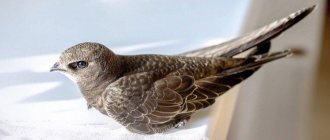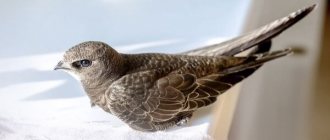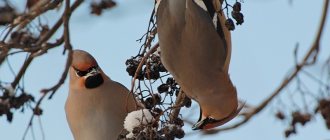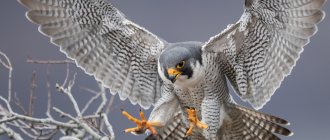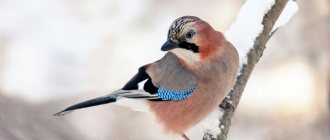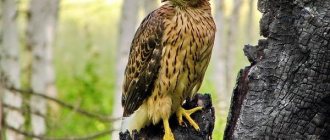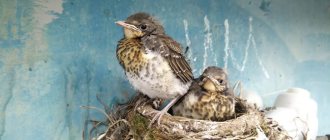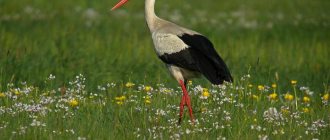| Latin name: | Apodidae |
| English name: | To be confirmed |
| Kingdom: | Animals |
| Type: | Chordata |
| Class: | Birds |
| Squad: | Swift-shaped |
| Family: | Swifts |
| Genus: | To be confirmed |
| Body length: | 16–22 cm |
| Wing length: | 15-18 cm |
| Wingspan: | 42-60 cm |
| Weight: | 25—140 g |
Description of the bird
A swift bird in a person's hand
A swift is a small bird, mostly gray in color with black and white splashes. Externally, the swift looks a little like a swallow. The body length of the bird is from 10 to 12 cm, the weight of adults is about 140 g. The head is large, the beak is sharp and small, the tail is straight, the wings are curved, long, the legs are weak and short. Rainbow is black.
— Advertising —
Relative to the body, the swift has very short legs, so if the bird is on the ground, then when it tries to take off, its long wings hit the surface of the ground and make it difficult to take off.
The plumage of males and females is the same, monochromatic, dark, occasionally with a metallic tint.
The swift's flight is characterized by very high speeds; some species are capable of reaching speeds of up to 120 km/h and higher. Swifts also have an unstable body temperature, like most species of birds, so in the event of a sharp cold snap, swifts fall into torpor, a short hibernation.
Migration
The question of whether swifts are migratory birds or not is easy to answer. Species living in areas with warm climates have a sedentary lifestyle. Species living in areas with cool autumn-winter periods are migratory birds. The main thing that swifts eat are insects, which disappear in winter. A bird can fast for up to 10 days. But then she will have to look for food, otherwise she will die. This is why swifts migrate from cold areas to countries with a predominantly warm climate for the winter. And, in the spring, when the swifts arrive, those familiar cries are heard again in the sky and restless birds scurry back and forth, as if reminding “Spring has come!” The warmth is back!
Swift eggs
What does it eat?
The swift flies with its beak open
– Advertisement –
The basis of the swifts' diet is insects flying in the air. Therefore, both the diet and lifestyle of these birds are closely related to weather conditions. For example, when insects disappear due to the onset of cold weather, swifts change their place of residence - they go nomadic in search of food.
When swifts are hungry, their body temperature drops significantly, which ends in hibernation, or “trance sleep.” Thanks to this adaptive adaptation of the body, swifts are able to survive hunger from one to ten days. Using “trance sleep,” little chicks wait for their parents when they fly long distances in search of food.
Natural enemies of swifts
Adult swifts have quite a few natural enemies, which is due to their high flight speed. Other birds simply cannot compete with swifts due to their extremely fast movements. Therefore, people do not often record attacks on these birds by other birds. In addition, swifts know how to strategically place their nests away from prying eyes. The high altitude and camouflage of the nest helps protect the offspring from attacks by predators that walk on the ground.
The location of the nests in the recesses helps to hide them from prying eyes, and the dark skin of the chicks and their feathers become an excellent camouflage for the babies themselves.
Special protective mechanisms, resulting from evolutionary adaptation, help swifts avoid most natural predators. Among the small number of birds that are hostile to swifts are:
- Yastrebov.
- Cheglokov.
- Common buzzards.
These are birds of prey that hunt smaller birds. Most often, attacks occur not on adults, but on newborn offspring or even on chicks that have not yet hatched from eggs.
A separate problem exists for black swifts, which are more endangered than others due to the harsh climate and weather conditions. The location of the nest in places characterized by high humidity creates a great danger for the chicks. It is due to the fact that babies can accidentally fly out of the nest ahead of time or fall, since the sides there are almost completely absent. If this happens, the chicks may be injured, and their feathers, due to falling into the water, will become heavier, and it will be more difficult for them to move.
Where does it live?
Swifts can be seen in almost every corner of the planet. The bird is not found only in very cold climatic zones. Swifts live both in forest areas and in open areas.
Mostly swifts like to live in big cities or on coastal cliffs, where it is convenient for birds to build nests. Swifts live in large flocks. Large colonies of these birds, consisting of several thousand pairs of swifts, can be seen in cities or in the mountains.
Among the numerous species of swifts, a distinction is made between sedentary and migratory populations. But in any case, the activity of these birds does not decrease from morning to evening.
Swifts spend almost all their time in flight; birds devote only a couple of night hours to sleep. The swifts' flying machine is almost perfect, and allows them to travel hundreds of kilometers. It seems that swifts do not know fatigue.
Character and lifestyle
These birds prefer to live in colonies. This way of life helps them keep everything under control, observe the changes around them and escape from possible danger in time.
Swifts are highly dependent on surrounding natural factors, climate and temperature conditions. The favorite pastime of swifts, if they are not in flight, is to sit on steep rocks, to which they skillfully cling with sharp claws.
Good nutrition is important for swifts. If they have problems with food, which especially often happens during cold periods, the swifts seem to turn on a reduced consumption of their “battery”. In other words, they become less active, as if they are in a mysterious daze. This helps the bird expend much less energy than usual.
This state can last up to several days, until better weather conditions arrive and it becomes possible to get food for yourself. It is also typical for small chicks.
But for them the reason for it is something else. This way the kids can wait for their parents to return from the hunt. The waiting time can last about 9 days. In total, swifts are active from early morning until evening.
Swifts migrate to wintering in warmer climes starting in August. Although it is impossible to determine the exact time for this, it all depends on the weather. If, in general, the weather conditions of the swifts are completely satisfactory, migration may be completely postponed.
Therefore, about some swifts we can say that they are sedentary birds. Such sedentary swifts are especially abundant in large cities, where the air temperature is usually higher than in a forest or steppe, for example.
Swift chick
According to the description, the swift bird has a hot temper. They cannot be called cunning or cautious. These big bullies have been seen more than once as instigators of fights in their circle or with other birds.
Often such fights are quite serious. At such moments, swifts forget about any caution and completely indulge in “war.” In flight, swifts are practically not disturbed or threatened by anything. The only bird that the swift should be wary of is the falcon.
Common types
Black or tower swift (Apus apus)
Black or tower swift
The bird reaches 18 cm in length, the wingspan is about 40 cm, the wing length is approximately 17 cm, the tail is 8 cm long. The bird's physique resembles a swallow. The tail is forked. The plumage color is dark brown with a greenish metallic sheen. The chin and neck are decorated with a white round spot. The iris is dark brown, the beak is black, the legs are light brown. The plumage of males and females is the same. The chicks are lighter than the adults, and their feathers have off-white edges at the tips. In summer, the black swift fades noticeably, and in general its plumage becomes much lighter.
The horizontal flight speed of the black swift reaches 111 km/h.
The species' habitat includes central Europe, northern and central Asia. In Russia, the bird is distributed from the western borders to Transbaikalia. Lives mainly in cities.
The black swift's wintering grounds are located in Africa and southern India. On their way, the birds fly across the entire continent from north to south. This species also winters in southeast Asia, in Thailand.
White-bellied Swift (Tachymarptis melba)
White-bellied swift in the sky
The body shape is streamlined, oblong, the wings are long and pointed. The tail is forked. The bird's body length is from 20 to 23 cm, the wingspan is 51-58 cm, the weight of adults is from 76 to 125 g. Females are slightly smaller in size than males.
The neck and top of the belly are pure white, there is a dark stripe on the chest. The underparts and upperparts are beige or gray-brown. The beak is black, the iris is brown-black. The paws are beige, the tips of the toes are dark brown with black claws.
The species is distributed in North Africa, Madagascar, southern Europe, central Europe, Western Asia, central Asia, India and Sri Lanka.
White-rumped or white-rumped swift (Apus pacificus)
A white-rumped swift flies over the sea.
The bird lives in eastern Asia. The species is migratory, migrating to south-east Asia and Australia for the winter. In addition to Asia, it was registered in the USA, New Zealand, and Europe (Denmark, Spain, Sweden, Great Britain). In body shape and plumage color it resembles a common swift, but differs from it in the white rump stripe. Females and males do not differ from each other; in young birds, the edges of feathers may be pale. The voice is screeching.
Pallid swift (Apus pallidus)
Pale swift
The bird's body length is 16-18 cm, weight ranges from 32 to 44 g. The tail is short and forked. The body is torpedo-shaped. The wings are long and sickle-shaped. The length of the wings is from 16.5 to 18 cm, the beak is small, about 0.5 cm long.
The pale swift is similar in appearance to the black swift. But his body is stockier, his plumage is generally lighter, and his belly is brownish. Against the background of the rest of the plumage, a white spot in the throat area stands out in contrast. The cry is piercing, high-pitched, and consists of a two-syllable “vri-e.”
The habitat of the species is North Africa, Southern Europe and the Middle East. It appears extremely rarely in Central Europe. The bird is migratory and migrates to tropical Africa for the winter.
Habitats
Swifts can easily fly from place to place. Even long distances are not significant for these birds.
A lot of them live in the western regions of China and Siberia, as well as in Spain. This bird also lives in more northern areas, for example, in Finland, Norway and the subarctic zone of Russia. They are found among the birds of the Moscow region .
They also love southern regions, for example, Turkey, Algeria, Lebanon, Morocco, Israel.
The breeding area of this bird can cover the whole of Europe and Central Asia. No settlements of swifts have been observed in India, Korea, Australia and most of China.
These birds live quite well on the equator, and for the winter they like to settle in the southern regions of Africa.
Reproduction
Swifts in the nest
In spring, migratory swifts return to their former habitats. They have an excellent memory, and the birds are very attached to nesting sites. As soon as they return, the swifts immediately begin building their nests and laying eggs. A female swift usually has 2 eggs in one clutch. The black swift has 4 of them. The female does incubation for two to three weeks. During this period, the male provides food for both himself and his spouse. After the chicks are born, they remain under the care of their parents for about 40 days, after which they leave the nest forever. The average lifespan of swifts is from 10 to 20 years.
What to feed and what not to feed a swift if you found it on the street and brought it home?
If you find a bird, bring it home and decide to help it, then a serious question is what you can feed and what you cannot feed. Let's look at these two lists in more detail.
It is strictly forbidden to feed swifts:
— Maggot for fishing;
- Cat soft and hard food, and nothing at all, including dog food;
- do not give sausages, sausages and similar products;
— industrial bird feed is prohibited;
- you can’t give carrots;
— chicken meat from the store is also not allowed;
- a mash for insectivorous birds made from insects is not allowed;
- any type of eggs, boiled or raw, no matter what kind of birds, is prohibited;
- sunflower seeds from the store, neither raw nor roasted;
- cottage cheese, sour cream and other dairy products from the store are not allowed;
- if you have sticky tape with flies hanging in your room, it is also forbidden to give them to swifts;
- In general, forget about feeding food that you and your pets eat.
Need to feed:
Since the main diet of swifts is insects, they need to be fed only with them, moreover, they must be caught directly from nature, and not raised somewhere in an aquarium for business.
— pupae (eggs) of forest red ants (Formica rufa). Also store in the freezer, before feeding, rinse on a sieve and blot with a napkin, a video of how swifts eat them is below;
— crickets, which need to be stored in the freezer, should be thawed before feeding and given after blotting them with a napkin to remove excess water. Do not feed rotten ones; you can identify them by their dark color and rotten smell. In female crickets, it is necessary to remove the eggs from the abdomen, since they are not digested by swifts;
— molted mealworm larvae, only white, soft, without chitinous cover;
— Turkmen cockroaches, feeding instructions below;
If you have prepared suitable food for your swift, but he does not open his mouth, below is a video on how to do this:
Swifts also need vitamins, so we recommend giving thiamine (B1) 1-2 drops in a volume of 0.04 ml every 5-7 days. Otherwise, the bird may experience convulsions due to vitamin deficiency.
Interesting Facts
Swift bird sitting on the fence
- Swifts are capable of reaching speeds of up to 170 km/h; they are real champions of high-speed flight among birds. For example, a swallow flies at a speed of 70 to 80 km/h. But at the same time, swifts can only fly. They cannot swim or walk because their legs are too small for this. When a swift finds itself on the ground, it is difficult for it to take off due to its large wingspan.
- To rise into the air, a swift needs a springboard or a hill. Therefore, swifts spend most of their lives in flight: looking for food, eating, drinking, obtaining building materials for the nest, and even mating. Moreover, these birds can even sleep in flight for several hours, occasionally flapping their wings.
- Some types of swifts build nests from saliva, which hardens in the air, they are called “swallow’s nests”, from which they cook the most delicious soup in the world that people eat.
Swifts' home
Different territories can become nesting sites for swifts. These include hollows of other birds, such as woodpeckers, and artificial areas built by human hands. For example, swifts often make nests in the voids of buildings.
They start construction later than other birds. Usually this moment occurs at the end of April, when the mating season begins. After the couple is formed, both spouses collect materials for the future home.
Question to the expert
How do swifts sleep?
Swifts can sleep not only in nests, like ordinary birds, but also while flying. In addition to the fact that swifts fall asleep on the fly, they can also glide in this way in one place. This happens when the swift gains a height of about three thousand meters. At the same time, it changes direction across to the wind and turns every minute. As a result, the swift flies along a set trajectory, remaining in one place. If there is a moderate wind, this trajectory looks like a circle; if it is strong, then it looks like a square or diamond.
Anything that swifts find becomes such materials: feathers, fluff, grass, small branches, straw, fabric, wool, etc. All this is glued together and forms a structure that resembles a round cup. Its sides are not high, usually they do not exceed one centimeter.
In the wild, swifts like to live at heights: on rocks or in tall trees. Therefore, even in the city they strive to build their nest in the highest place.
A nest being built for the first time is usually not too large. Its diameter is about 9 cm, and the width of the tray is no more than 5 cm. However, gradually the dwelling begins to grow and becomes larger. An improved nest can reach up to 15 cm in diameter with a width of 8 cm. At the same time, the sides also rise to 3 cm.
In urban environments, swifts often place their nests under eaves, on the roof, and in cracks. In the wild, they are usually found on tree branches and sometimes in hollows.
Swift nest on the balcony
Some species of swifts show great vigilance and caution during construction. They strive to camouflage the nest from ill-wishers, preventing other birds from attacking and destroying their home.
